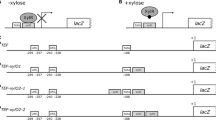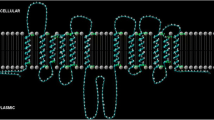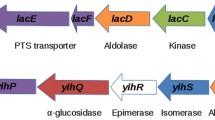Summary
The Bacillus subtilis xyl operon encoding enzymes for xylose utilization is repressed in the absence of xylose and in the presence of glucose. Transcriptional fusions of spoVG-lacZ to this operon show regulation of β-galactosidase expression by glucose, indicating that glucose repression operates at the level of transcription. A similar result is obtained when glucose is replaced by glycerol, thus defining a general catabolite repression mechanism. A deletion of xylR, which encodes the xylose-sensitive repressor of the operon, does not affect glucose repression. The cis element mediating glucose repression was identified by Bal31 deletion analysis. It is confined to a 34 by segment located at position + 125 downstream of the xyl promoter in the coding sequence for xylose isomerase. Cloning of this segment in the opposite orientation leads to reduced catabolite repression. The homology of this element to various proposed consensus sequences for catabolite repression in B. subtilis is discussed.
Similar content being viewed by others
References
Anagnostopoulos C, Spizizen J (1960) Requirements for transformation in Bacillus subtilis. J Bacteriol 81:741–746
Birnboim HC, Doly J (1979) A rapid alkaline extraction procedure for screening recombinant plasmid DNA. Nucleic Acids Res 7:1513–1523
Boyer HW, Roulland-Dussoix D (1969) A complementation analysis of the restriction and modification of DNA in Escherichia coli. J Mol Biol 41:459–472
Boylan SA, Chun KT, Edson BA, Price CW (1988) Early-blocked sporulation mutations alter expression of enzymes under carbon control in Bacillus subtilis. Mol Gen Genet 212:271–280
de Crombrugghe B, Busby S, Buc H (1984) Cyclic AMP receptor protein: Role in transcription activation. Science 224:831–838
Deutscher J, Sossna G, Gonzy-Treboul G (1989) Regulatory functions of the phosphocarrier protein HPr of the phosphoenol pyruvate-dependent phosphotransferase system in Gram-positive bacteria. FEMS Microbiol Rev 63:167–174
Fisher SH, Magasanik B (1984) 2-Ketoglutarate and the regulation of aconitase and histidase formation in Bacillus subtilis. J Bacteriol 158:379–382
Fisher SH, Sonenshein AL (1991) Control of carbon and nitrogen metabolism in Bacillus subtilis. Microbiol Rev, in press
Fouet A, Sonenshein AL (1990) A target for carbon source dependent negative regulation of the citB promoter of Bacillus subtilis. J Bacteriol 172:835–844
Fouet A, Jin S, Raffel G, Sonenshein AL (1990) Multiple regulatory sites in the Bacillus subtilis citB promoter region. J Bacteriol 172:5408–5415
Fujita Y, Miwa Y (1989) Identification of an operator sequence for the Bacillus subtilis gnt operon. J Biol Chem 264:4201–4206
Gärtner D, Geissendörfer M, Hillen W (1988) Expression of Bacillus subtilis xyl operon is repressed at the level of transcription and is induced by xylose. J Bacteriol 170:3102–3109
Hardy KG (1985) Bacillus cloning methods. In: Glover DM (ed) DNA cloning, a practical approach, vol 2. IRL Press, Oxford, Washington DC, pp 1–17
Hastrup S (1988) Analysis of the B. subtilis xylose regulon. In: Granesan AT, Hoch JA (eds) Genetics and biotechnology of Bacilli, vol 2. Academic Press, New York, pp 79–83
Hillen W, Klein RD, Wells RD (1981) Preparation of milligram amounts of 21 deoxyribonucleic acid restriction fragments. Biochemistry 20:3748–3756
Kreuzer P, Gartner D, Allmansberger R, Hillen W (1989) Identification and sequence analysis of the Bacillus subtilis W23 xylR gene and xyl operator. J Bacteriol 171:3840–3845
Mach H, Hecker M, Mach F (1984) Evidence for the presence of cyclic adenosine monophosphate in Bacillus subtilis. FEMS Microbiol Let 22:27–30
Maniatis T, Fritsch EF, Sambrook J (1982) Molecular cloning: a laboratory manual. Cold Spring Harbor Laboratory Press, Cold Spring Harbor, NY
Martin I, Debarbouille M, Klier A, Rapoport G (1989) Induction and metabolite regulation of levanase synthesis in Bacillus subtilis. J Bacteriol 171:1885–1892
Melin L, Rutberg L, von Gabain A (1989) Transcriptional and posttranscriptional control of the Bacillus subtilis succinate dehydrogenase operon. J Bacteriol 171:2110–2115
Miller JH (1972) Experiments in molecular genetics. Cold Spring Harbor Laboratory Press, Cold Spring Harbor, NY, pp 352–355
Miwa Y, Fujita Y (1990) Determination of the cis sequence involved in catabolite repression of the Bacillus subtilis gnt operon; implication of a consensus sequence in catabolite repression in the genus Bacillus. Nucleic Acids Res 18:7049–7053
Moran Jr CP, Lang N, Le Grice SFJ, Lee G, Stephens M, Sonenshein AL, Pero J, Losick R (1982) Nucleotide sequences that signal the initiation of transcription and translation in Bacillus subtilis. Mol Gen Genet 186:339–346
Murphy N, McConnell DJ, Cantwell BA (1984) The DNA sequence of the gene and genetic control sites for the excreted B. subtilis enzyme β-glucanase. Nucleic Acids Res 12:5355–5366
Nicholson WL, Park YK, Henkin TM, Won M, Weickert MJ, Gaskell JA, Chambliss GH (1987) Catabolite repression — resistant mutations of the Bacillus subtilis alpha amylase promoter affect transcription levels and are in an operator — like sequence. J Mol Biol 198:609–618
Perkins JB, Youngman PJ (1986) Construction and properties of T017-lac, a transposon derivative that mediates transcriptional gene fusions in Bacillus subtilis. Proc Natl Acad Sci USA 83:140–144
Reizer J, Novotny MJ, Stuiver I, Saier Jr MH (1984) Regulation of glycerol uptake by the phosphoenolpyruvate-sugar phosphotransferase system in Bacillus subtilis. J Bacteriol 159:243–250
Reizer J, Saier Jr MH, Deutscher J, Grenier F, Thompson J, Hengstenberg W (1988) The phosphoenolpyruvate:sugar phosphotransferase system in Gram-positive bacteria: properties, mechanisms and regulation. CRC Crit Rev Microbiol 15:297–338
Rosenkrantz MS, Dingman DW, Sonenshein AL (1985) Bacillus subtilis citB gene is regulated synerigistically by glucose and glutamine. J Bacteriol 164:155–164
Sanger F, Nicklen S, Coulson AR (1977) DNA sequencing with chain-terminating inhibitors. Proc Natl Acad Sci USA 74:5463–5467
Shimotsu H, Henner D (1986) Construction of a single copy integration vector and its use in analysis of regulation of the trp operon of Bacillus subtilis. Gene 43:85–94
Southern EM (1975) Detection of specific sequences among DNA fragments separated by gel electrophoresis. J Mol Biol 98:503–517
Weickert MJ, Chambliss GH (1990) Site-directed mutagenesis of a catabolite repression operator sequence in Bacillus subtilis. Proc Natl Acad Sci USA 87:6238–6242
Wilhelm M, Hollenberg CP (1984) Selective cloning of Bacillus subtilis xylose isomerase and xylulokinase genes in Escherichia coli by IS5-mediated expression. EMBO J 3:2555–2560
Wilhelm M, Hollenberg CP (1985) Nucleotide sequence of the Bacillus subtilis xylose isomerase gene: extensive homology between the Bacillus and the E. coli enzyme. Nucleic Acids Res 13:5717–5722
Youngman P (1987) Plasmid vectors for recovering and exploiting Tn917 transpositions in Bacillus and other Gram positive bacteria. In: Hardy KG (ed) Plasmids, a practical approach. IRL Press, Oxford, Washington DC, pp 79–103
Author information
Authors and Affiliations
Additional information
Communicated by W. Goebel
Rights and permissions
About this article
Cite this article
Jacob, S., Allmansberger, R., Gärtner, D. et al. Catabolite repression of the operon for xylose utilization from Bacillus subtilis W23 is mediated at the level of transcription and depends on a cis site in the xylA reading frame. Molec. Gen. Genet. 229, 189–196 (1991). https://doi.org/10.1007/BF00272155
Received:
Issue Date:
DOI: https://doi.org/10.1007/BF00272155




